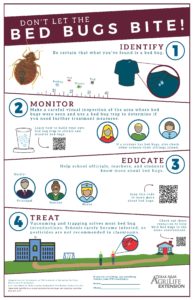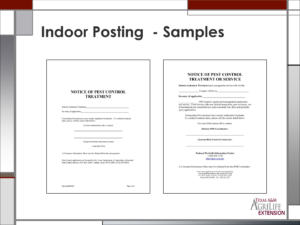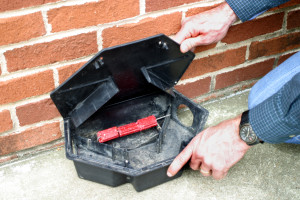As the new school year starts this is a good time to remind your staff about your IPM program.

Education can be conveyed using posters, newsletter, emails or personal communications.
Many of your new teachers may not be aware of the TX school IPM law and rules, it is your job as the District IPM coordinator to inform them of this rule and ensure they know what to do if they have pest problems. One of the best things you can do is send out is an email reminder letting them know if they see a pest or pest activity to let you know. Reminding them about things like doors that don’t seal properly, signs of water leaks, or areas not being cleaned regularly can all lead to potential pest problems. You will also want to make sure all of the school staff is aware that only licensed pest management professionals can make pesticide applications. That they can’t bring pest control products to school, that includes snap traps, glue boards and pesticides.
The School IPM rules require that by the first week of school attendance, ensure that a procedure is in place to provide prior notification of pesticide applications to parents, or guardians of children attending the facility in writing that pesticides are periodically applied indoors and outdoors, and that information on the times and types of applications and prior notification is available upon request.

The sign on the left is the standard 48 posting notification that TDA publishes on their website. The sign on the right is something AgriLife Extension developed with TDA for schools to use.
This is also a good time to remember that for ALL indoor pesticide applications the law still requires that you must post a pest control sign in an area of common access at least 48 hours prior to each planned indoor treatment and make a consumer information sheet available to any individual working or residing in the building upon the request of that individual. This includes using items like roach or ant gel baits, crack and crevice treatments, and other Green Category products. Things that are exempt from 48-hour posting are non-pesticide control measures, non-pesticide monitoring tools and mechanical devices, such as glue boards, snap traps, insect light traps, and live traps. School 48 hour posting sign
On school district property you are required to post a sign at the time of any pesticide application. This sign will remain in place based on the category of the product and if there any additional label restrictions. For Green Category products the sign must go up prior to the application and can be removed once the application is done. Yellow Category products the sign must go up prior to the application and must remain in place 4 hours AFTER the application is complete. Red Category requires that the sign remain in place 8 hours AFTER the application is complete and you follow the posting like Green and Yellow. Remember for all Yellow and Red Category products the pesticide applicator must complete a Justification form.
While we are on the subject of outdoor treatments, I have received calls and emails asking about the using glyphosate on school property. Currently there are no restrictions on using this product or any other pesticide product provided it is registered (licensed) by the U.S. EPA and TDA. In some counties in TX, the Department of Agriculture does have restrictions on certain herbicides so be sure to check with your pesticide distributor before you purchase any new product. Check out this handout from Dr. Scott Nolte on Glyphosate Info

Be sure to keep bait stations clean and with fresh bait. Make sure they are secure so that children or non-target animals can open or move.
Finally, the other question I receive a lot has to do with the use of rodenticides on school property. It’s been almost a decade since the EPA implemented the Rodenticide Mitigation Decision which limits how rodenticide formulations are manufactured and sold. This decision was to tighten safety standards to reduce risks to humans, pets, and non-target wildlife. Where a specific product is authorized for use depends upon whether the bait station component of the product has been shown to be resistant to tampering by young children and by dogs as well as whether the unit has been found to be weather-resistant. Read the labels of these products before purchasing any of them to make sure that the product obtained is labeled for use in the place(s) that you intend to apply it. When it comes to rodent management this is one tool in your toolbox, sealing doors, plumbing penetrations and other ways that mice and rats can enter a building is one of the best things you can do to prevent rodents from entering a structure.
For more information on Understanding the EPA Rodenticide Risk Mitigation Decision this link will take you to the National Pest Management Associations document on this topic. It’s worth the read.

 .
.